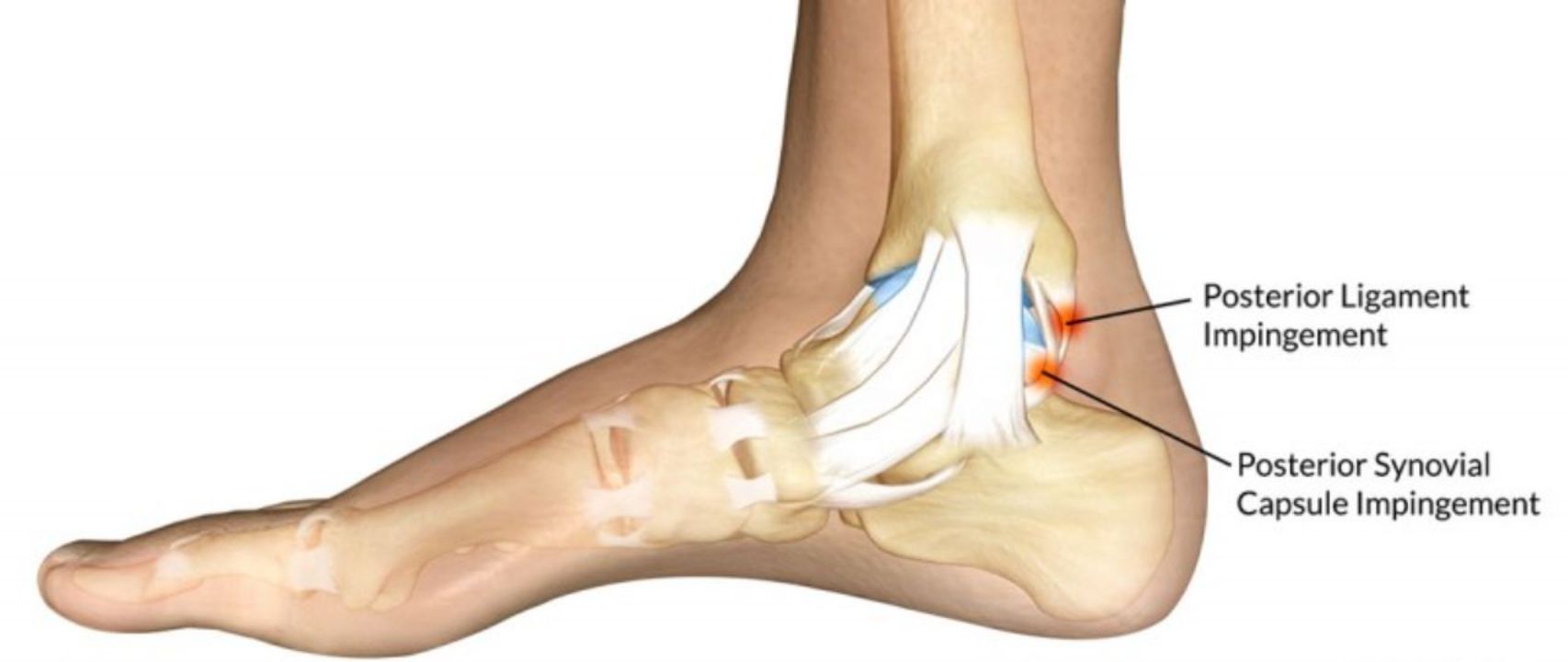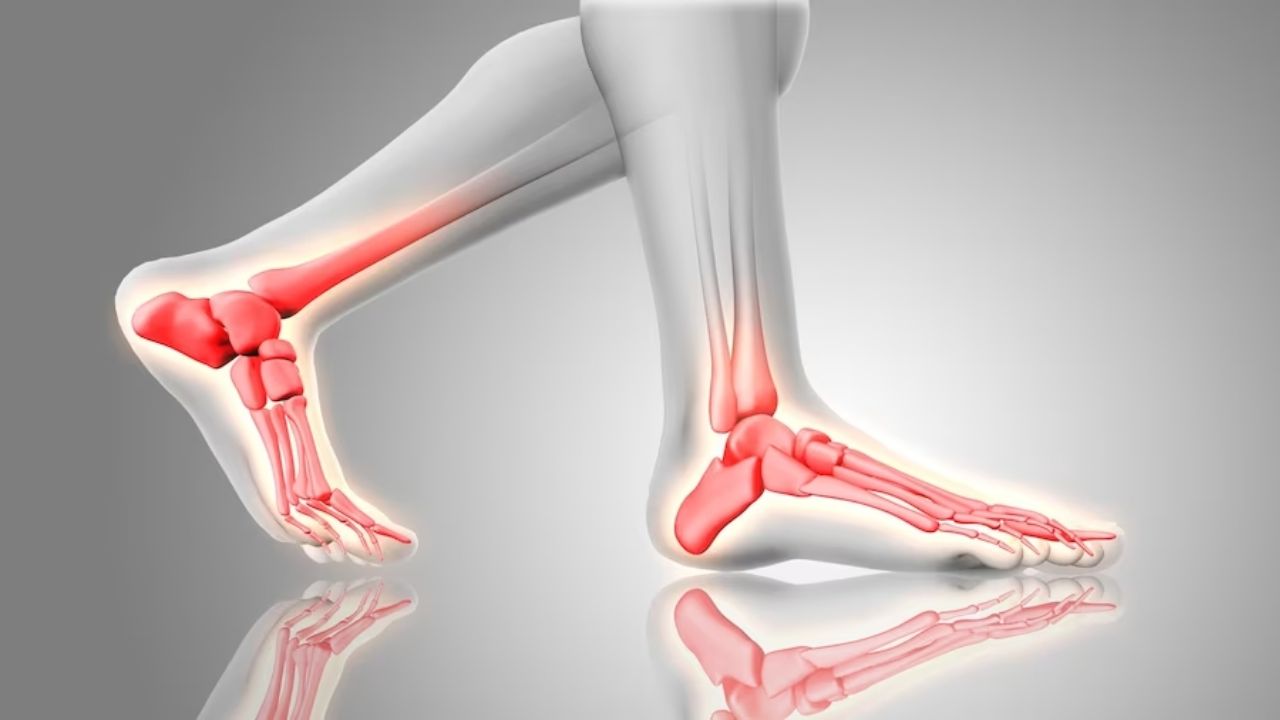Posterior Ankle Impingement, also known as “dancer’s heel,” is typically caused by repetitive or excessive plantarflexion, which is the movement of pointing the foot and toes downward. This can lead to irritation and inflammation of the structures at the back of the ankle. Some of the common causes include:
- Overuse: This is particularly common in athletes or individuals who engage in activities that require repetitive or excessive plantarflexion, such as ballet dancers, soccer players, and runners.
- Trauma: An injury to the ankle, such as a sprain or fracture, can cause swelling and scar tissue formation that results in impingement.
- Anatomical variations: Some individuals may have an extra bone or soft tissue at the back of the ankle that can lead to impingement.
- Arthritis: Inflammatory conditions such as arthritis can lead to swelling and changes in the joint that result in impingement.
The Symptoms and Diagnosis of Posterior Ankle Impingement
In contrast to anterior ankle impingement, the primary symptom of Posterior Ankle Impingement is pain at the back of the ankle, which can be exacerbated by activities that involve pointing the foot and toes downward. Other symptoms may include:
- Swelling: This is often localised to the back of the ankle and may be more noticeable after physical activity.
- Stiffness: Individuals may find that their ankle does not move as freely as it used to, particularly in the direction of plantarflexion.
- Decreased range of motion: The pain and stiffness can lead to a reduced ability to move the ankle, particularly in the direction of pointing the foot and toes downward.
- The sensation of pinching or catching: Some individuals may feel a sensation of pinching or catching in the ankle during certain movements.
Diagnosis of Posterior Ankle Impingement typically involves a physical examination and a review of the patient’s medical history. During the physical examination, the doctor may manipulate the ankle to assess the range of motion and identify any areas of pain. Imaging tests, such as X-rays, MRI, or ultrasound, may be used to visualise the bones and soft tissues of the ankle and identify any abnormalities.
Treatment Options for Posterior Ankle Impingement

Photo Credit: Capital Area Physical Therapy
Treatment for Posterior Ankle Impingement typically involves a combination of conservative measures and, in some cases, surgical intervention. Conservative treatments may include:
- Rest: Avoiding activities that exacerbate the pain can help to reduce inflammation and promote healing.
- Ice: Applying ice to the affected area can help to reduce swelling and alleviate pain.
- Medication: Nonsteroidal anti-inflammatory drugs (NSAIDs) can help to reduce inflammation and alleviate pain.
- Physical therapy: Specific exercises can help strengthen the ankle muscles, improve flexibility, and promote healing.
In cases where conservative treatments are not effective, surgical intervention may be considered. This could involve arthroscopic surgery to remove bone spurs or other abnormalities causing the impingement.
The Risks Associated with Posterior Ankle Impingement
While Posterior Ankle Impingement can often be managed with conservative treatments, some risks are associated. These include:
- Chronic pain: If left untreated, it can lead to chronic pain at the back of the ankle.
- Decreased mobility: The pain and stiffness can limit the ankle’s range of motion, affecting an individual’s ability to perform certain activities.
- Risk of re-injury: Individuals with this ailment may be at a higher risk of re-injuring the ankle, particularly if they return to high-impact activities too soon.
Tips for Managing Posterior Ankle Impingement
 Photo Credit: jcomp, Freepik
Photo Credit: jcomp, Freepik
Managing Posterior Ankle Impingement typically involves a combination of treatment and lifestyle modifications. These may include:
- Regular physical therapy: Regular physical therapy can help to improve strength and flexibility in the ankle.
- Modification of activities: Avoiding activities that exacerbate the pain can help to prevent further damage.
- Use of supportive devices: In some cases, wearing a brace or using crutches can help reduce ankle strain and promote healing.
- Regular follow-ups with your doctor: This can help to monitor your progress and adjust your treatment plan as necessary.
Understanding the Anatomy of the Posterior Ankle
The posterior ankle is a complex structure made up of several bones, including the tibia, fibula, and talus, as well as various ligaments and tendons. Understanding the anatomy of the posterior ankle can help to understand the causes and treatment options for Posterior Ankle Impingement. Key structures involved in Posterior Ankle Impingement include:
- Achilles tendon: This is the largest tendon in the body and connects the calf muscles to the heel bone. Overuse or injury to this tendon can contribute to posterior ankle issues.
- Posterior talofibular ligament: This ligament connects the talus and fibula at the back of the ankle. Damage or inflammation of this ligament can lead to impingement.
- The flexor hallucis longus: This tendon runs along the back of the ankle and can be involved in Posterior Ankle Impingement.
Stretching and Strengthening Exercises for Posterior Ankle Impingement

Photo Credit: Racool_studio, Freepik
Physical therapy plays a crucial role in the treatment of Posterior Ankle Impingement. Specific exercises can help strengthen the ankle muscles, improve flexibility, and promote healing. These may include:
- Calf stretches can help stretch the muscles at the back of the lower leg, reducing tension on the Achilles tendon and alleviating symptoms.
- Ankle range of motion exercises: These can help to improve flexibility and reduce stiffness in the ankle.
- Balance and proprioception exercises: These can help improve balance and body awareness, reducing the risk of re-injury.
- Strengthening exercises: These can help to strengthen the muscles around the ankle, providing better support and stability.
It’s important to perform these exercises under the guidance of a physical therapist or other healthcare professional to ensure they are done correctly and safely.
The Link Between Posterior Ankle Impingement and Other Foot Injuries
Posterior Ankle Impingement can be associated with other foot and ankle injuries. For instance, individuals with flat feet or overpronation may be more prone to developing posterior ankle issues due to the altered biomechanics of their feet and ankles. Similarly, individuals who have had a previous ankle injury, such as an ankle sprain, may be at a higher risk of developing this syndrome due to the formation of scar tissue or joint changes resulting from the injury.
Sports and Activities to Avoid with Posterior Ankle Impingement

Photo Credit: kjpargeter, Freepik
Certain sports and activities can exacerbate the symptoms of Posterior Ankle Impingement and should be avoided, particularly during the acute phase of the condition. These may include:
- High-impact activities: Sports such as running, jumping, or any activity that involves a lot of impact or force on the ankle can exacerbate symptoms.
- Plantarflexion: Activities involving excessive plantarflexion include ballet dancing, hill running, and certain yoga poses.
- High Heels: Wearing high heels can place the ankle in a position of plantarflexion, which can exacerbate symptoms.
The Benefits of Early Intervention for Posterior Ankle Impingement
Early intervention for Posterior Ankle Impingement can help to alleviate symptoms, prevent further damage, and improve the overall prognosis. Benefits of early intervention may include:
- Reduced pain and inflammation: Early treatment can help to reduce the inflammation and alleviate the pain.
- Improved mobility: Early intervention can help improve the ankle’s range of motion and prevent the development of stiffness.
- Prevention of further damage: By addressing the condition early, it’s possible to prevent further damage to the ankle structures.
- Improved quality of life: By managing the symptoms, individuals can maintain their ability to perform daily activities and enjoy a better quality of life.
Frequently Asked Questions (FAQs) About Posterior Ankle Impingement
How do you treat posterior ankle impingement?
Treatment for posterior ankle impingement typically involves a combination of rest, physical therapy, and medication to reduce inflammation. In severe cases, surgical intervention may be necessary.
How long does it take for a posterior ankle impingement to heal?
The recovery time for posterior ankle impingement can vary depending on the severity of the condition and the individual’s overall health. Following the treatment plan provided by your healthcare provider can help ensure the best possible outcome.
What causes posterior ankle impingement syndrome?
Posterior ankle impingement syndrome is typically caused by repetitive or excessive plantarflexion, which is the movement of pointing the foot and toes downward. This can lead to irritation and inflammation of the structures at the back of the ankle.
Can posterior ankle impingement lead to other foot injuries?
Yes, posterior ankle impingement can be associated with other foot and ankle injuries. For instance, individuals with flat feet or overpronation may be more prone to developing posterior ankle impingement due to the altered biomechanics of their feet and ankles.
What sports should I avoid if I have posterior ankle impingement?
High-impact sports such as running and jumping and activities involving excessive plantarflexion, such as ballet dancing or hill running, should be avoided as they can exacerbate the symptoms of posterior ankle impingement.
What are the benefits of early intervention for posterior ankle impingement?
Early intervention for posterior ankle impingement can help to alleviate symptoms, prevent further damage, and improve the overall prognosis. This includes reduced pain and inflammation, improved mobility, prevention of further damage, and improved quality of life.
What role does physical therapy play in the treatment of posterior ankle impingement?
Physical therapy plays a crucial role in the treatment of posterior ankle impingement. Specific exercises can help strengthen the ankle muscles, improve flexibility, and promote healing.
Can wearing high heels exacerbate posterior ankle impingement?
Yes, wearing high heels can place the ankle in a position of plantarflexion, which can exacerbate the symptoms of posterior ankle impingement.

 Photo Credit: jcomp, Freepik
Photo Credit: jcomp, Freepik
